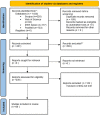mHealth in sub-Saharan Africa and Europe: A systematic review comparing the use and availability of mHealth approaches in sub-Saharan Africa and Europe
- PMID: 37377558
- PMCID: PMC10291558
- DOI: 10.1177/20552076231180972
mHealth in sub-Saharan Africa and Europe: A systematic review comparing the use and availability of mHealth approaches in sub-Saharan Africa and Europe
Abstract
Background: mHealth can help with healthcare service delivery for various health issues, but there's a significant gap in the availability and use of mHealth systems between sub-Saharan Africa and Europe, despite the ongoing digitalization of the global healthcare system.
Objective: This work aims to compare and investigate the use and availability of mHealth systems in sub-Saharan Africa and Europe, and identify gaps in current mHealth development and implementation in both regions.
Methods: The study adhered to the PRISMA 2020 guidelines for article search and selection to ensure an unbiased comparison between sub-Saharan Africa and Europe. Four databases (Scopus, Web of Science, IEEE Xplore, and PubMed) were used, and articles were evaluated based on predetermined criteria. Details on the mHealth system type, goal, patient type, health concern, and development stage were collected and recorded in a Microsoft Excel worksheet.
Results: The search query produced 1020 articles for sub-Saharan Africa and 2477 articles for Europe. After screening for eligibility, 86 articles for sub-Saharan Africa and 297 articles for Europe were included. To minimize bias, two reviewers conducted the article screening and data retrieval. Sub-Saharan Africa used SMS and call-based mHealth methods for consultation and diagnosis, mainly for young patients such as children and mothers, and for issues such as HIV, pregnancy, childbirth, and child care. Europe relied more on apps, sensors, and wearables for monitoring, with the elderly as the most common patient group, and the most common health issues being cardiovascular disease and heart failure.
Conclusion: Wearable technology and external sensors are heavily used in Europe, whereas they are seldom used in sub-Saharan Africa. More efforts should be made to use the mHealth system to improve health outcomes in both regions, incorporating more cutting-edge technologies like wearables internal and external sensors. Undertaking context-based studies, identifying determinants of mHealth systems use, and considering these determinants during mHealth system design could enhance mHealth availability and utilization.
Keywords: Digital health; Europe; eHealth; healthcare; mHealth; sub-Saharan Africa.
© The Author(s) 2023.
Figures







References
-
- Källander K, Tibenderana JK, Akpogheneta OJ, et al. Mobile health (mHealth) approaches and lessons for increased performance and retention of community health workers in low- and middle-income countries: a review. J Med Internet Res 2013 Jan 25; 15: e17–e17. https://pubmed.ncbi.nlm.nih.gov/23353680 . doi: 10.2196/jmir.2130 - DOI - PMC - PubMed
-
- Hossein SM. Consideration of the relationship between ICT and eHealth. J Biol Agric Healthc 2015; 2: 49–59.
-
- Emmanouilidou M. The status of mHealth in Europe and a review of regulative challenges. In: L. R, M. M (eds) 2016 International Conference on E-Health, EH 2016 [Internet]. Kent Business School, University of Kent, Canterbury, Kent, CT2 7NZ, United Kingdom: IADIS; 2016. p.203–6. https://www.scopus.com/inward/record.uri?eid=2-s2.0-85040195146&partnerI....
-
- Messner EM, Probst T, O’Rourke T, et al. mHealth applications: potentials, limitations, current quality and future directions. In: Baumeister H and Montag C (eds) Digital phenotyping and mobile sensing: new developments in psychoinformatics. Ulm, Germany: Ulm Univ, Clin Psychol & Psychotherapy, 2019. pp.235–248.
Publication types
LinkOut - more resources
Full Text Sources
Miscellaneous

